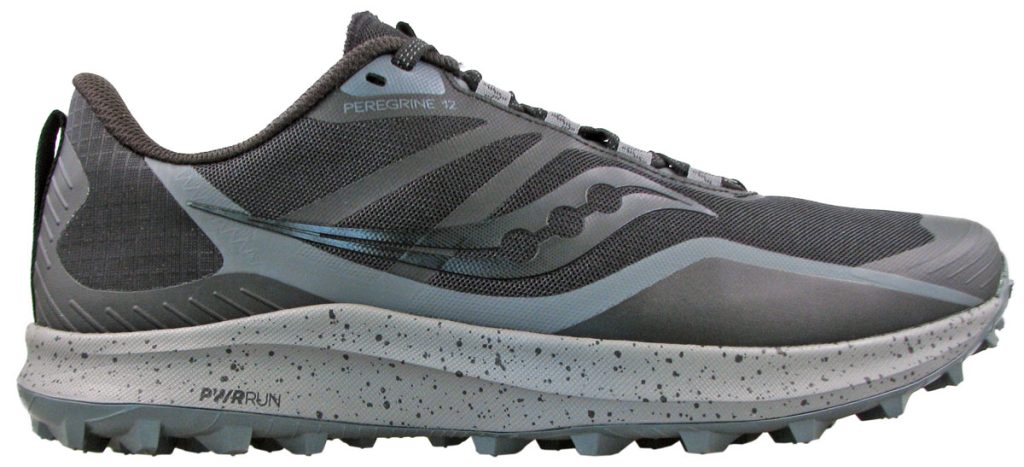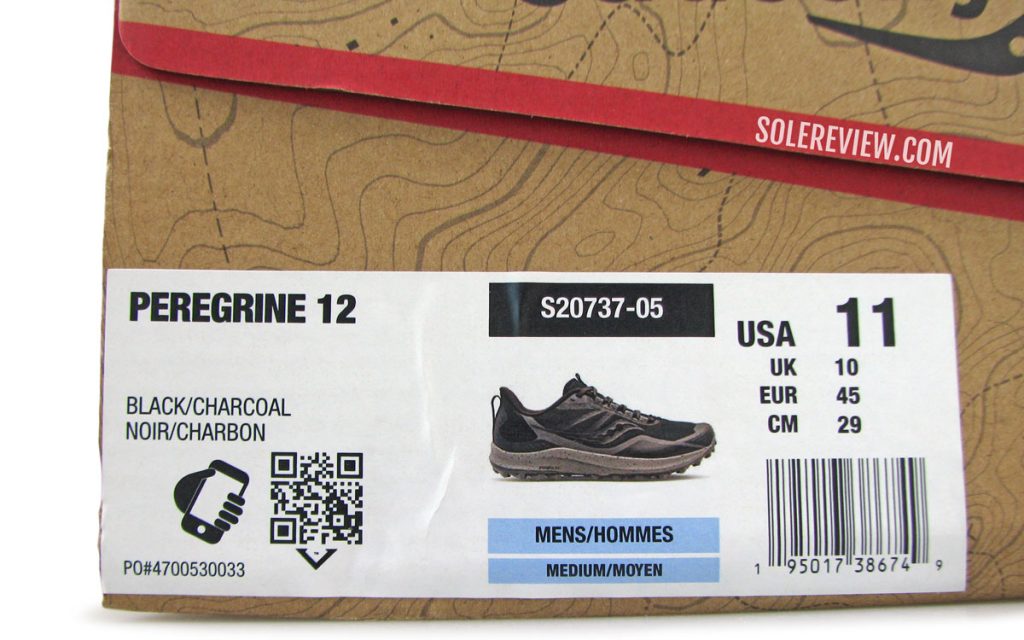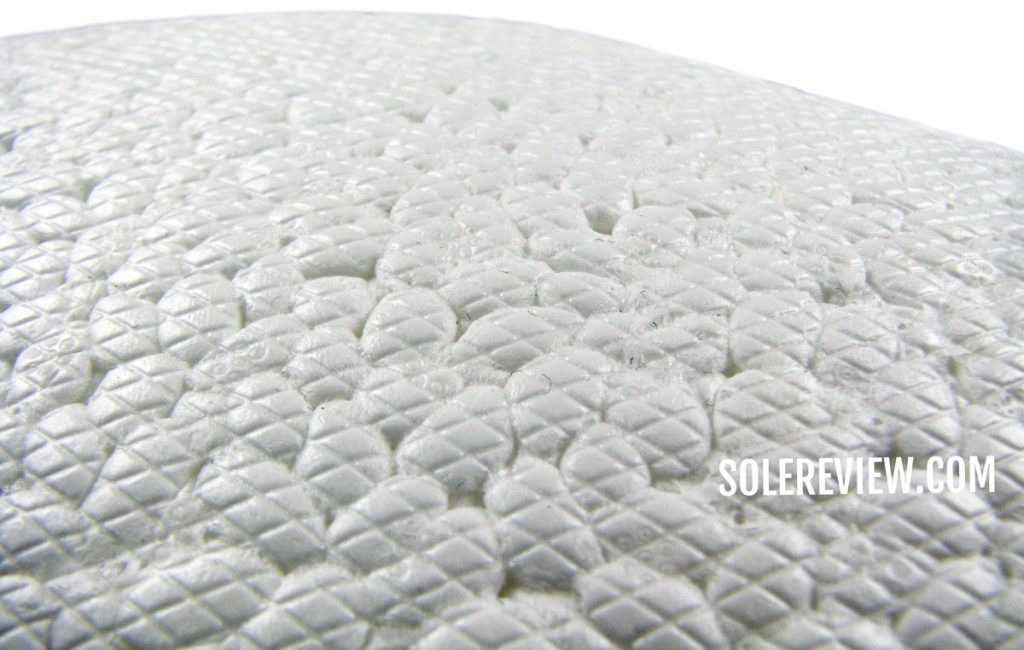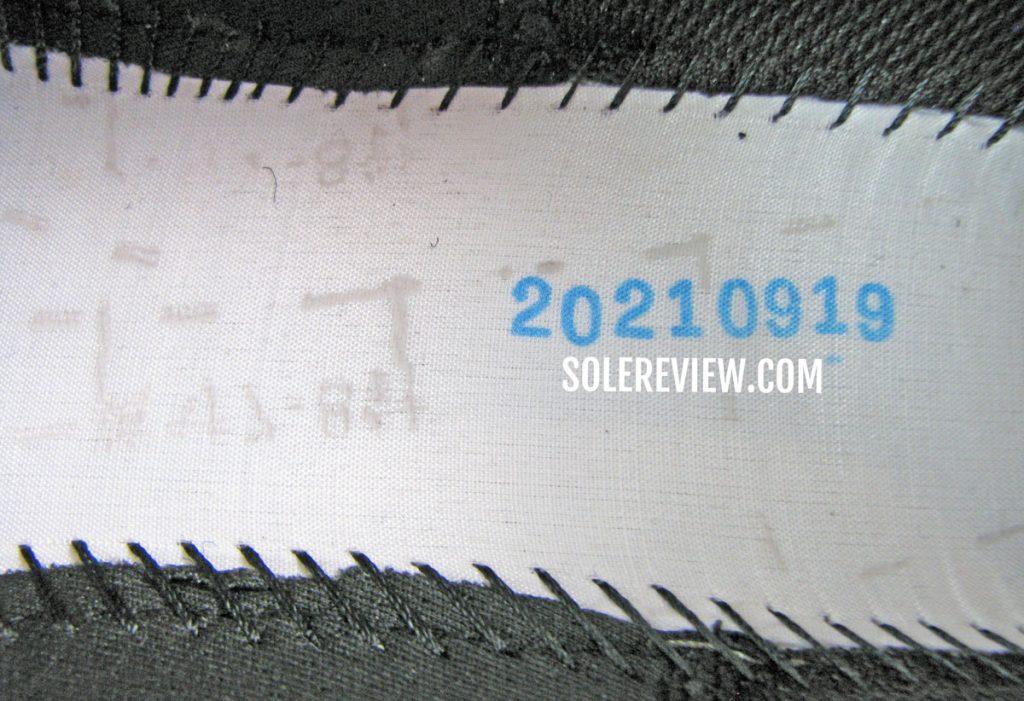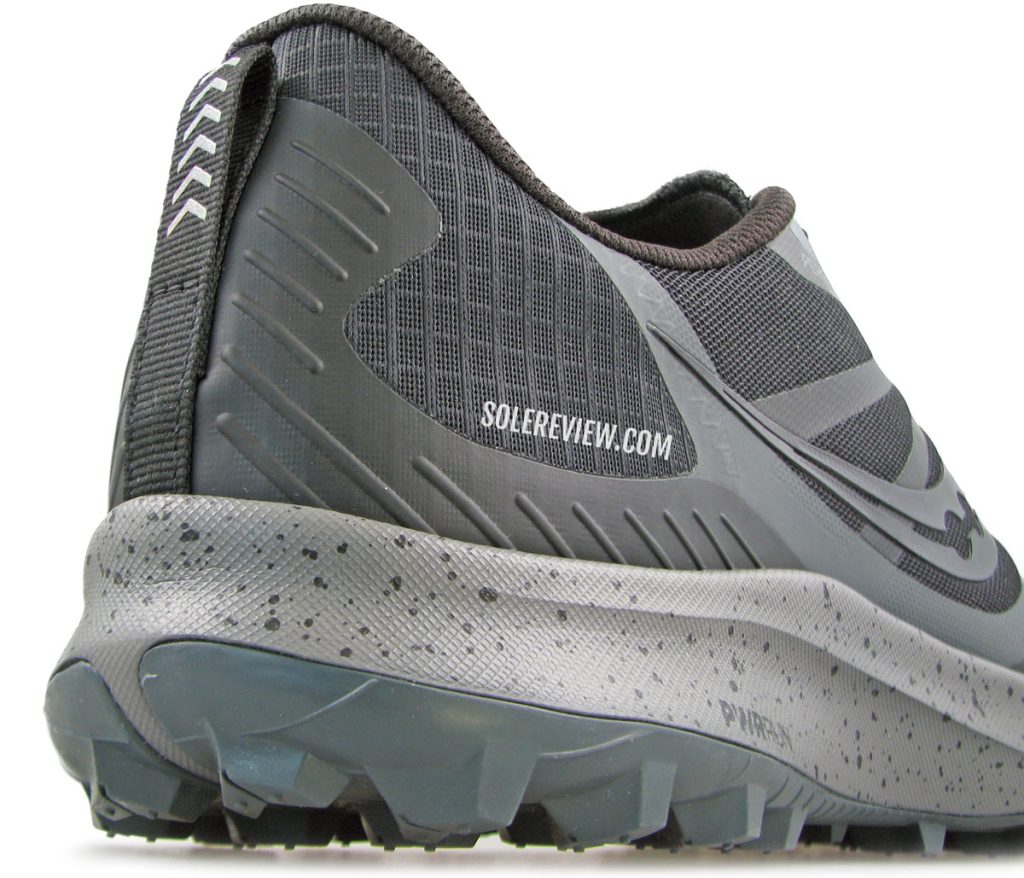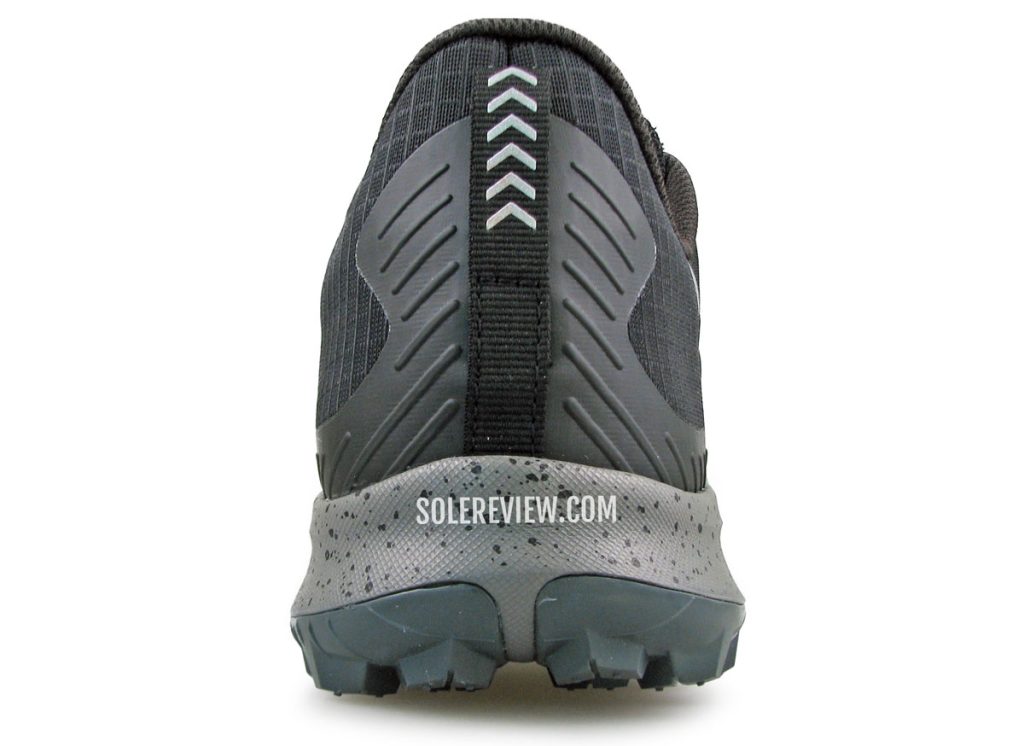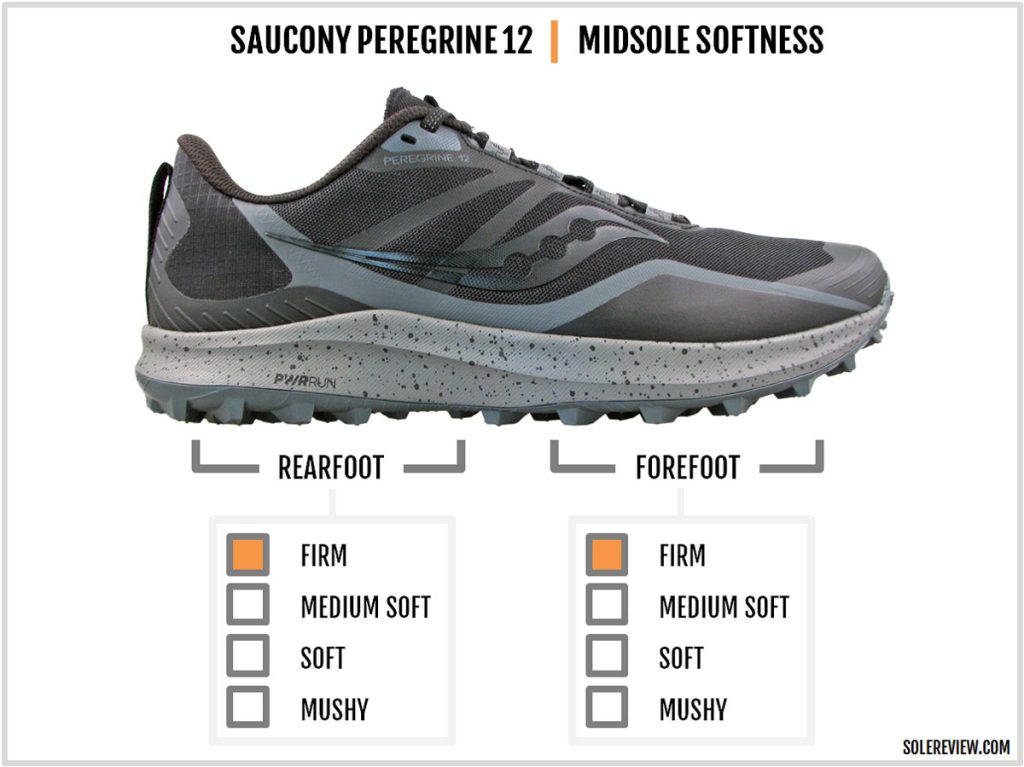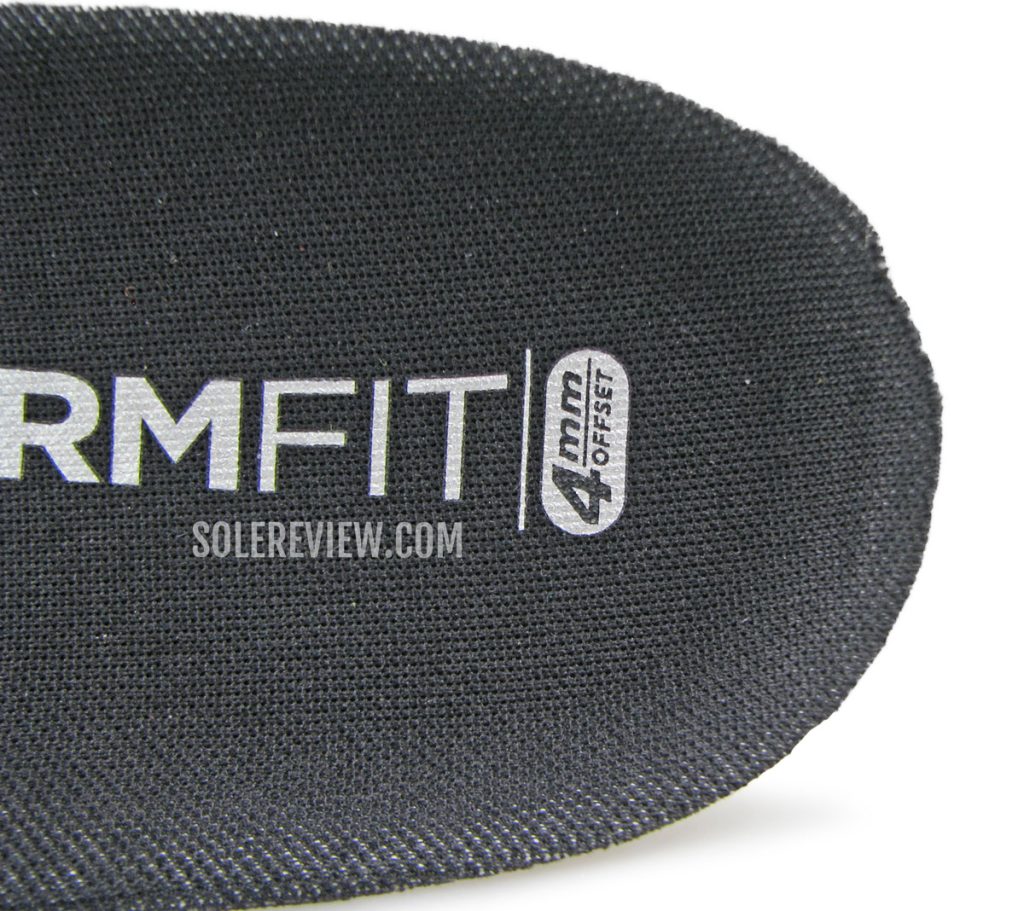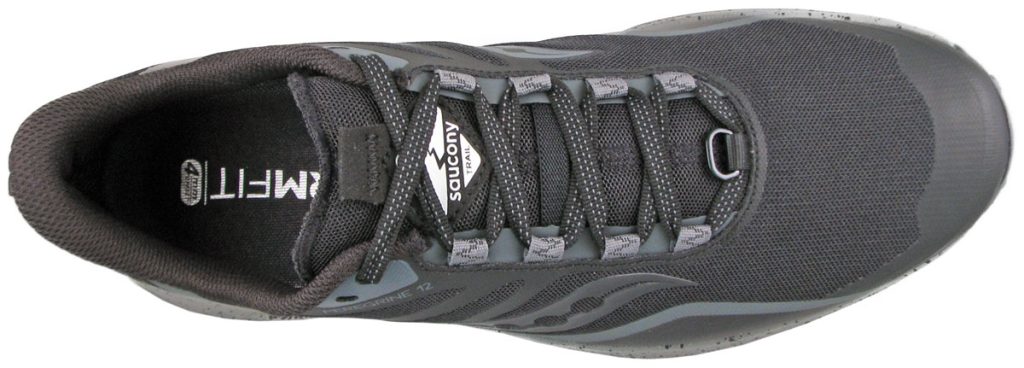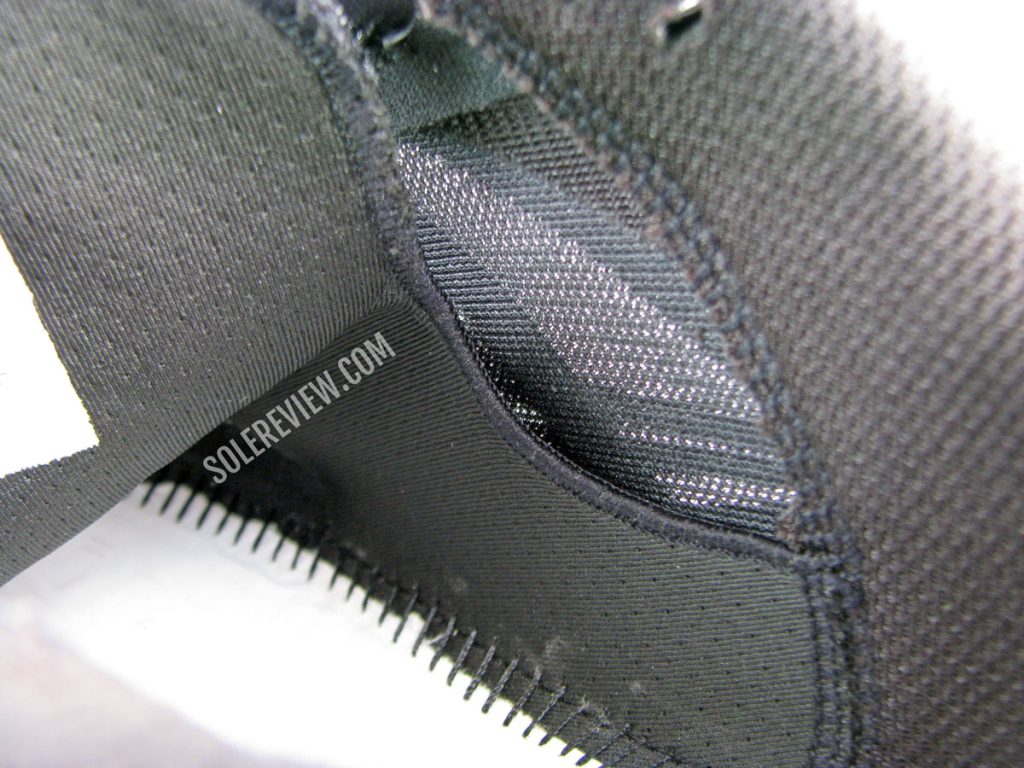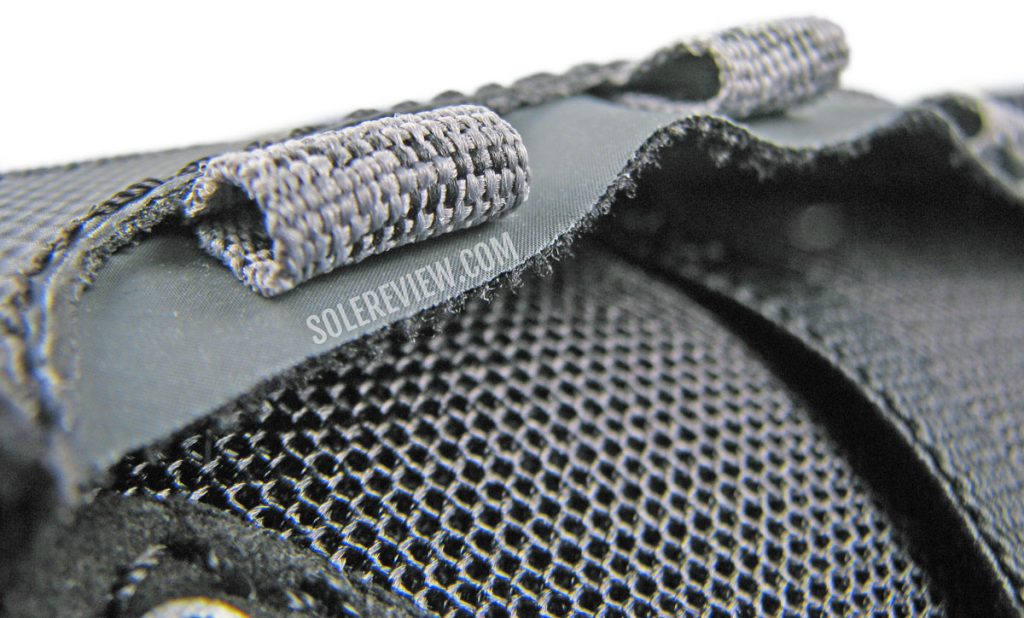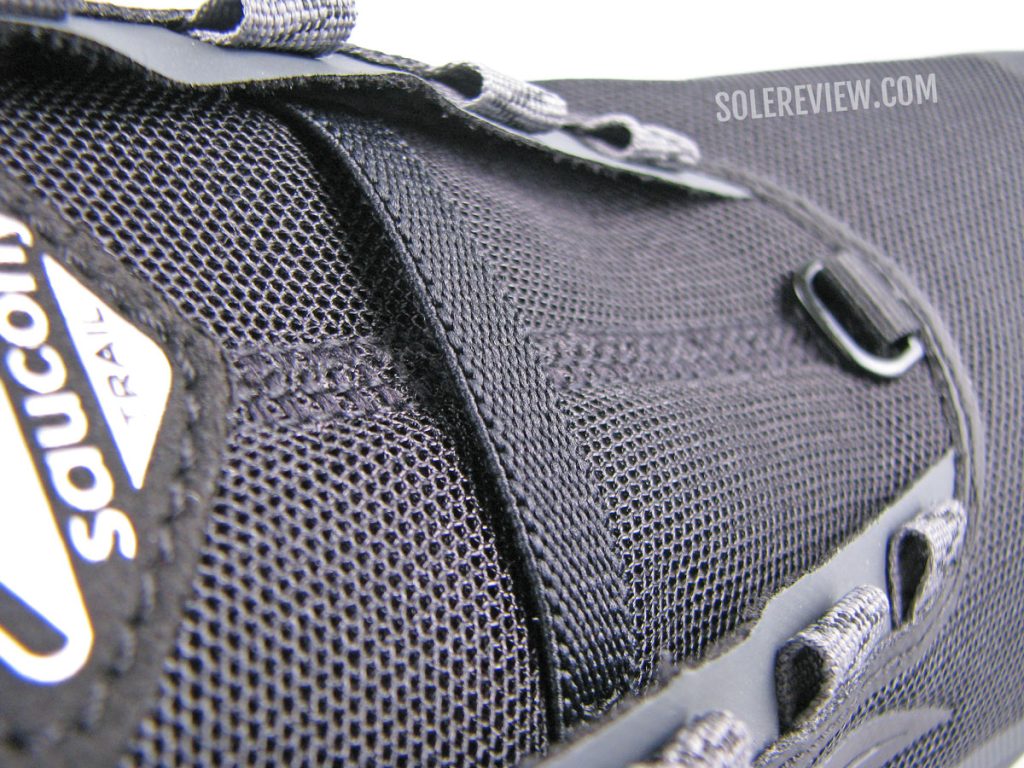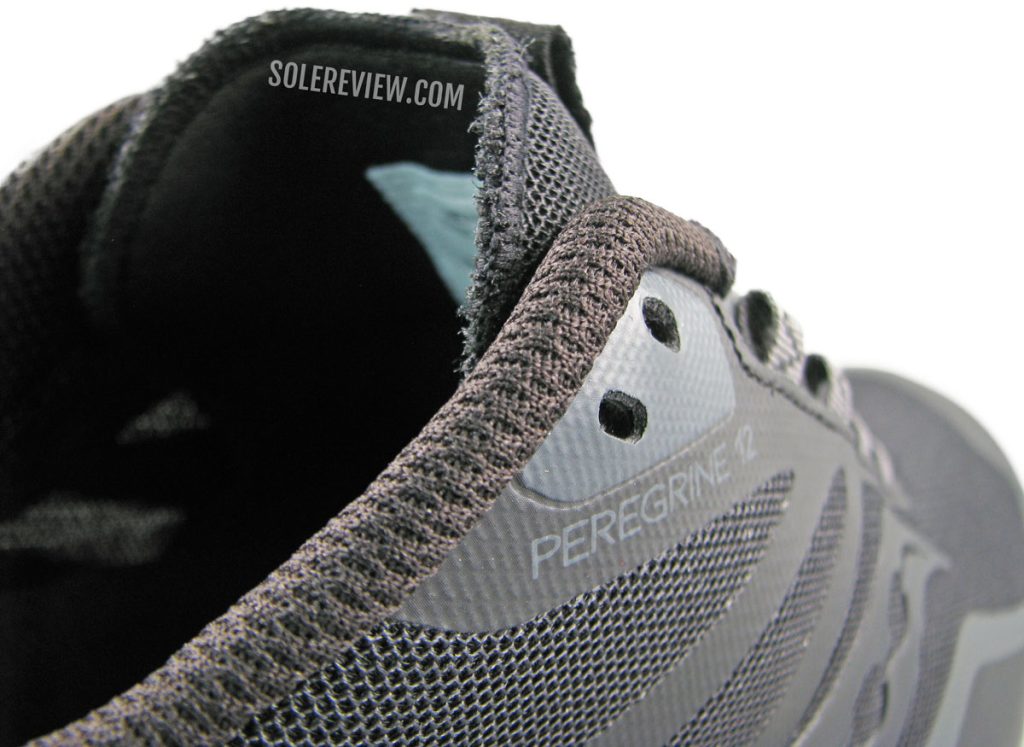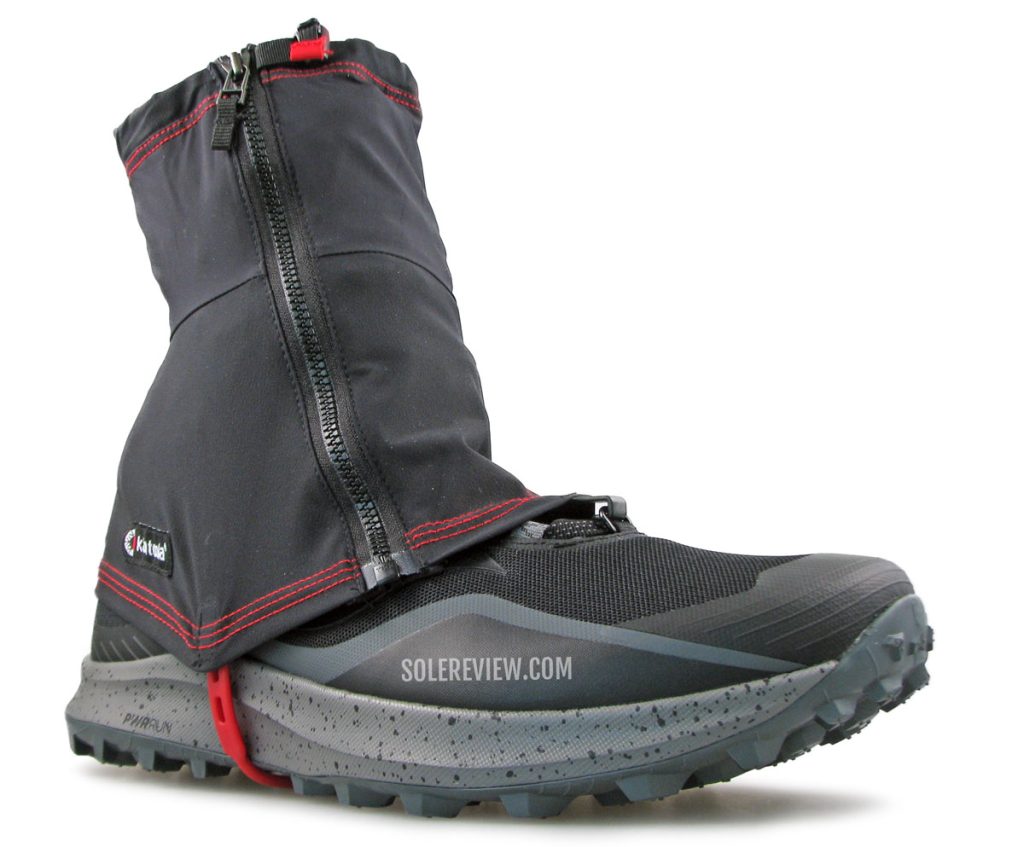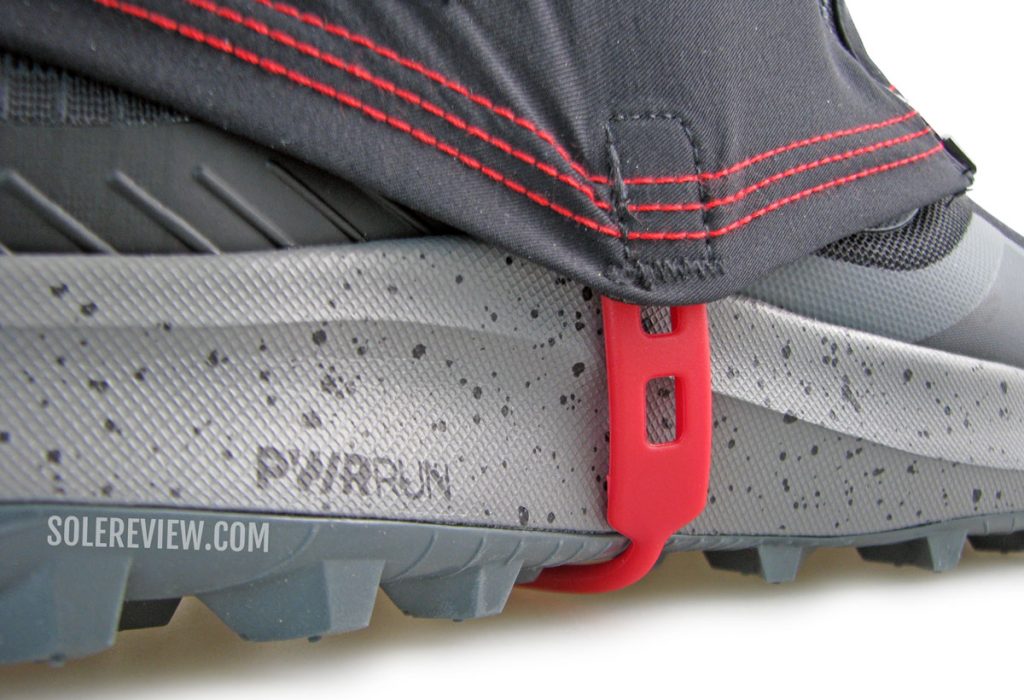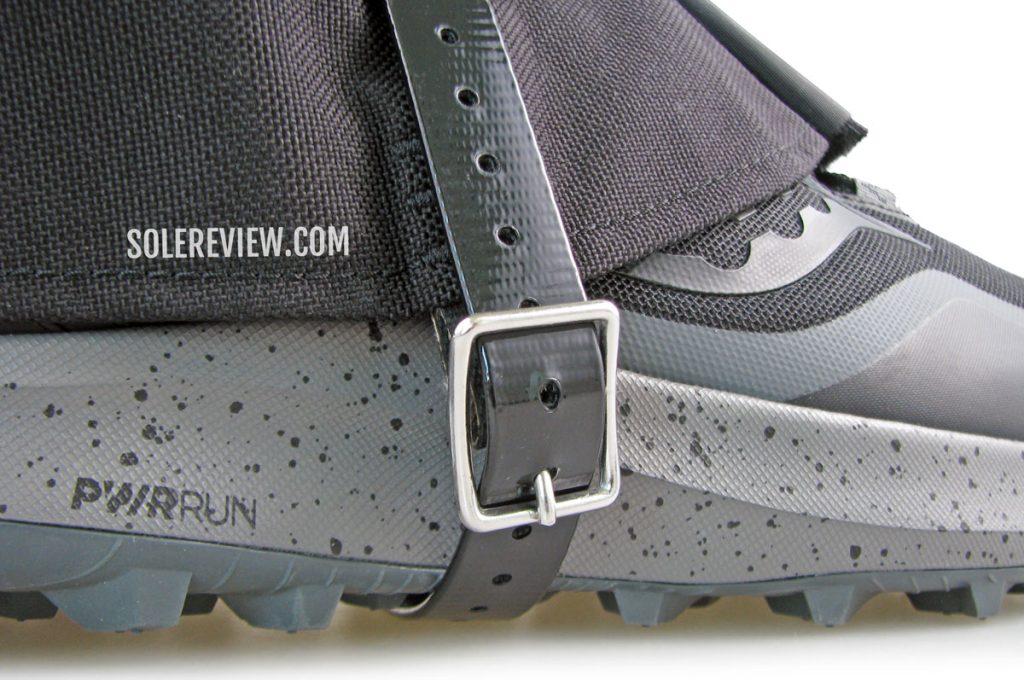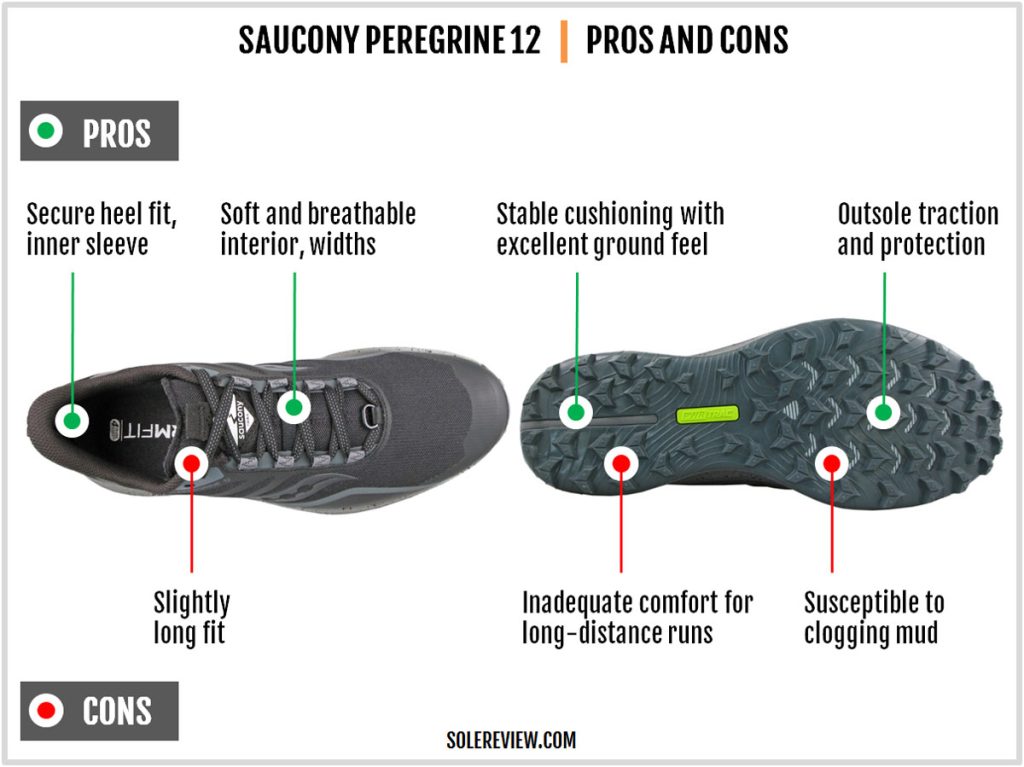
The Saucony Peregrine 12 was purchased at full retail price for our review. The amount is in Canadian Dollars.
INTRODUCTION
The Peregrine is the most popular trail running shoe in Saucony’s catalog.
Its 4 mm heel-to-toe offset is somewhat of a rarity in the trail running shoe universe, but there’s an established precedent – the 4 mm drop Kinvara is one of Saucony’s most successful road models.
In addition to sharing an identical heel-to-toe drop, there are other parallels between the Peregrine and Kinvara.
Both the models are designed with speed-friendly comfort in mind, and rely on a minimally constructed upper. The balanced meld of performance attributes makes the Kinvara and Peregrine suitable for many use cases.
For example, the Peregrine 12’s firm EVA foam midsole (Pwrrun) is well behaved during fast trail runs.
The relatively low stack heights (26.5 mm rear, 22.5 mm forefoot) and single-density midsole make the transitions stable, smooth, and efficient. The low heel drop midsole has no rear overhang, so the Peregrine 12 works for all foot-strike patterns.
It’s worth noting that while Saucony has named the shoe after the Peregrine Falcon – a bird that can dive bomb at speeds up to 200 miles (390 km) an hour – this running shoe is not a trail racer.
Like the Kinvara, the Peregrine 12 has a higher level of cushioning and protection than a true trail racer like the now-discontinued New Balance Summit Unknown.
Also, the Peregrine isn’t your one trail shoe to do it all.
For example, while it suffices for everyday trail runs of distances up to 5K – 10 K, it’s neither a balanced road-trail hybrid like the Nike Pegasus Trail 3, nor an ultra-worthy shoe like the Hoka Challenger ATR 6 or New Balance More Trail V3.
THE SAUCONY PEREGRINE 12 VERSUS PEREGRINE 11
Inflation is at an all-time high, so a $10 price increase is now the expected norm.
But the question is – do we get anything in return?
Despite the brand new midsole and outsole, the Peregrine 12 has a similar ride character as the 11.
However, there’s one notable difference. Instead of an EVA insole and a Pwrrun+ (E-TPU) topsole, the 12 has a thick insole that’s made entirely of expanded-Polyurethane.
By increasing the level of step-in comfort, the Pwwrun+ insole makes a difference in how the shoe feels at slower speeds. With a 0.3 ounce (35 gram) weight difference, the 12 is also a lighter shoe than the 11.
Lastly, the new outsole no longer comes with blank markers for the drainage ports and spikes. The Peregrine 11’s outsole had raised circles with ‘plus’ and ‘dot’ symbols – those were blanks for attaching aftermarket spikes and drilling drainage holes.
THE RIDE EXPERIENCE
The Peregrine has always been a trail shoe with a firm ride, and the V12 stays true to its character.
With rear and front stack heights of 26.5 mm and 22.5 mm, the 4 mm drop midsole isn’t very tall. The EVA-blend Pwrrun foam has a high density with minimal softness.
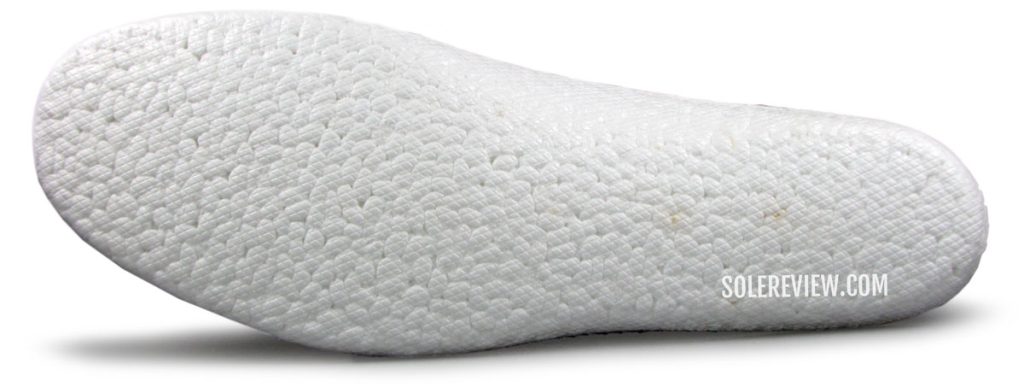
Everun, Pwrrun+ – call it whatever you will. The unique insole is no longer EVA foam, but steam-expanded Polyurethane.
However, the latest model has a new trick up its sleeve, and it’s a thick insole made of Pwrrun+ foam. Not to be confused with the midsole material, Saucony’s Pwrrun+ foam is made of expanded Polyurethane. It’s the same compound as the adidas Boost, but firmer.
The Peregrine 11 also had Pwrrun+, but it was in the form of a much thinner ‘Topsole’ under an EVA foam footbed. This time, there’s no ‘Topsole’ or EVA insole – just a chunky layer of Pwrrun+ over a fabric lasting.
So does the new insole make a difference to the ride quality? It does at lower speeds, but once the Peregrine picks up speed, it’s easy to forget that the insole is made of E-TPU.
At walking speeds, the new footbed produces a noticeable sensation of step-in softness. On the trail, the Pwrrun+ layer blends into the rest of the midsole to produce a firm yet cushioned ride.
The expanded PU foam footbed performs equally well in freezing temperatures, and is resistant to compression fatigue. In other words, the cushioning is weather-proof, and the insole will outlast the shoe.
The outsole layout is similar to the Peregrine 11, so that translates into a sticky Pwrtrac rubber outsole with closely-spaced 5 mm lugs.
They grip well on dry trails and rocks. However, like any rubber outsole, the lugs struggle on algae-coated rocks, snow, ice, and wet metal footbridges.
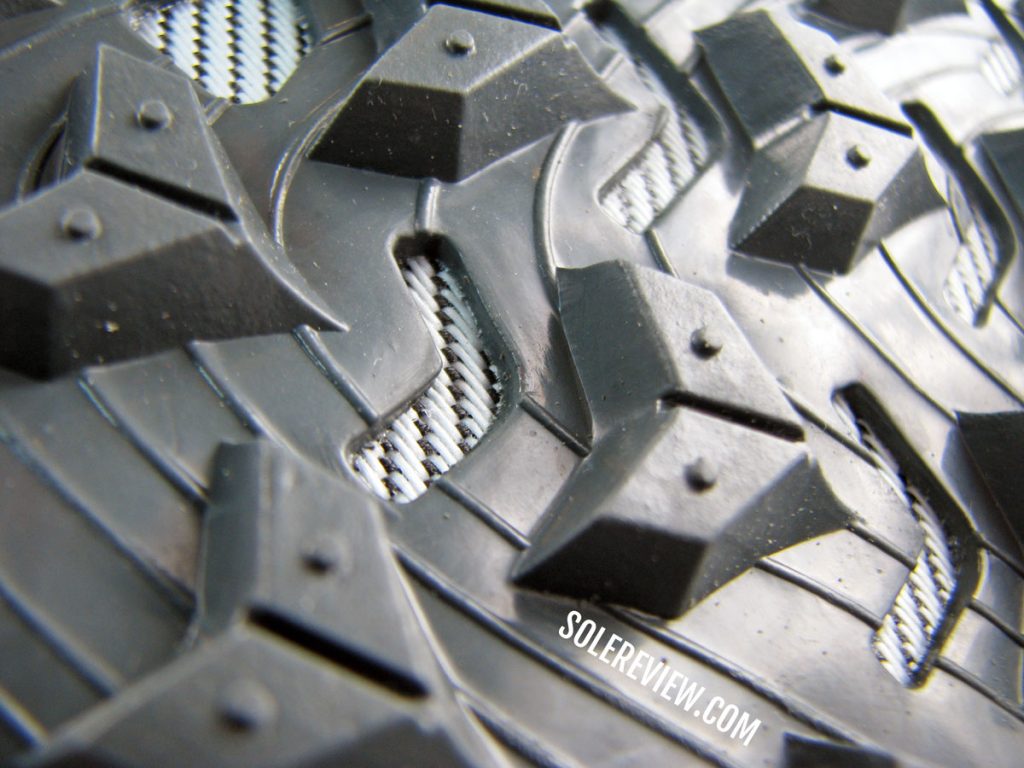
The Peregrine’s rock plate isn’t a ‘plate’ per se, but a woven layer that offers flexible protection.
A flexible rock plate is sandwiched between the midsole and outsole, and does an excellent job of protecting the foot against roots and large gravel.
And it’s not a stiff plate, but a woven kind that flexes together with the midsole. During runs, it’s hard to tell that it’s even there.
There’s a good reason why Saucony sells the ST (Soft Terrain) version of the Peregrine 12 with a concealed rock plate and longer (6.5 mm) lugs with wider spacing.

The outsole is ‘sticky’ for sure. The closely-spaced lugs and exposed rock shield tends to clog on soft terrain.
The outsole of the non-ST Peregrine tends to get clogged with mud; the dense lug configuration and woven surface of the rock plate appear to be the culprits.
On the trail, the Saucony Peregrine 12 performs as promised. The firm ride is good for fast trail runs, and the low-profile midsole and flexible rock shield promote proprioception.
The enhanced ground feedback make the Peregrine suitable for technical trails, as it’s easier to find the footing on challenging terrain.
With a firm midsole comes excellent stability. The Peregrine feels planted on uneven terrain, and the transitions are smooth. The outsole is split under the heel for a better range of motion during landings.
There’s no cushioning bias either, so the Peregrine feels very neutral.
If you were thinking of making the Saucony Peregrine 12 your do-everything trail running shoe, that may not be a good idea. The Peregrine’s low-profile midsole lacks cushioning comfort for an ultra or even on-road use.
Though the Peregrine can be occasionally used as a road-trail hybrid, it’s nowhere as comfortable as say, the Brooks Cascadia 16 (our review is here) or Nike Pegasus Trail 3. (Our review is here)
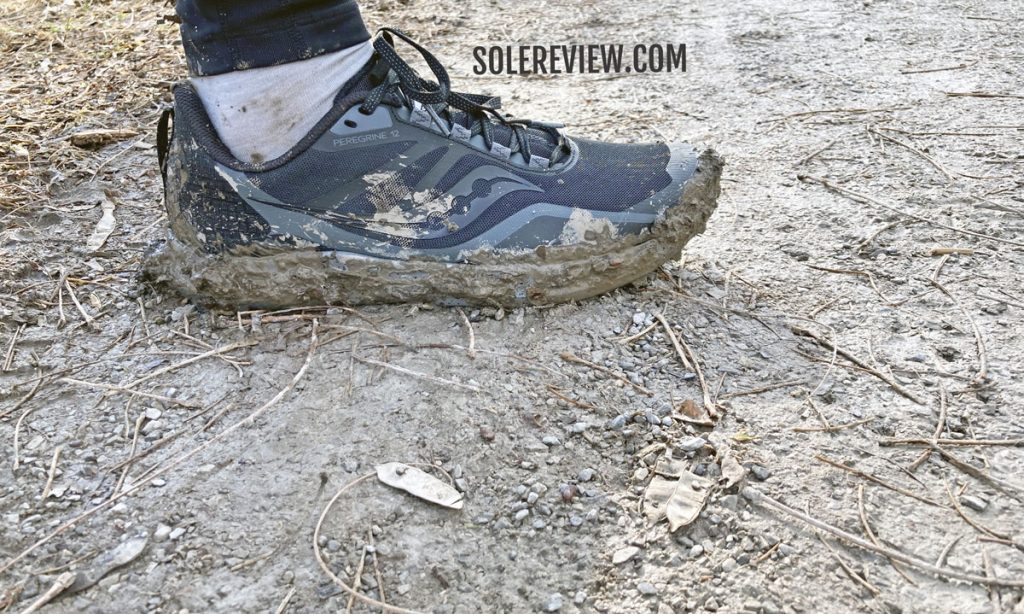
Though the Peregrine is excellent for speed runs, it’s found wanting in ride comfort during high-mileage runs on flat trails or roads.
From a comfort standpoint, the Peregrine fares slightly better on flat unpaved trails, but even then, a cushier midsole does feel better. That’s been an age-old conundrum with trail running shoes – it’s hard for a fast and proprioceptive ride to co-exist with mileage-friendly cushioning.
Thus, the Peregrine is best used as a part of a two-shoe rotation.
For example, the Nike Pegasus Trail 3 and Peregrine complement each other perfectly. Use the Saucony shoe for speed runs on technical trails, and the Pegasus Trail for longer runs on flat sections.
Finally, it’s worth pointing out that the low 4 mm offset will stress the Achilles and Calves/Soleus during uphill trail runs.
So if you’re in the early stages of transitioning from a higher drop (8-10 mm) trail shoe, our advice is to take it slow and gentle the first few runs.
IS THE SAUCONY PEREGRINE 12 DURABLE?
Like any trail running shoe, the Peregrine 12’s lifespan will depend on how it’s used.
When used as a mixed surface trail running shoe that involves paved roads and flat gravel trails, the outsole will wear down sooner. If it’s just off-road use on soft trails, then you’ll be able to extract a higher mileage.
From a structural standpoint, all parts of the shoe appear trail-worthy.
The rubber outsole and rock plate protect the midsole, and the firm cushioning is resistant to flattening. As we all know, the Pwrrun+ (expanded Polyurethane) footbed is very durable.
The mesh exterior is reinforced in damage-susceptible areas like the forefoot and toe-box.
THE UPPER DESIGN AND FIT
The Saucony Peregrine 12’s fit feels a lot like some of recent Asics running shoes – snug in the forefoot, but long in the front. And yet, we recommend buying true-to-size.
The extra margin comes in handy during downhill runs, and besides, the forefoot, midfoot, and heel have a secure fit.
A partial sleeve holds the soft tongue in position, so there’s no slide. Even though the tongue is lightly padded, the elastic laces cinch smoothly without applying top-down pressure.
The speed lacing loops also make the Peregrine quick to fasten.
The midfoot has a secure fit, but we think that the upper would be better served by a variable width lacing. That would allow the midfoot to be cinched tighter if needed. Narrow-footed runners will surely appreciate the feature, given that the Peregrine isn’t sold in a narrow (B) width.
The midfoot panel has a soft strip under the loops to make the lacing flush over the tongue and also decrease the chances of friction-led wear and tear.
The interior is soft and breathable. The thin mesh allows the upper to breathe well, thus making the Peregrine an excellent summer trail running shoe. The thin mesh performs better than expected at keeping the debris out.
Admittedly, most of our test runs took place on damp trails, but the dried mud did not get inside the shoe.
The upper is reinforced in areas where they are needed; the fused toe bumper and forefoot overlays offer protection.
The padded heel has a stiff counter that locks the foot in place during uphill climbs.
We don’t see a Gore-Tex version of the Peregrine 12 yet, but in the interim, the ST model offers a debris shield and a closer-knit mesh.
GAITER COMPATIBILITY

If this D-Ring is missing on a shoe, then it’s not compatible with a gaiter. Fortunately, the Peregrine 12 has one.
Generally speaking, two things make a running shoe compatible with gaiters. The first feature is a D-ring on the forefoot that allows the gaiter hook to be attached.
Without this D-ring, it’s very hard to get a gaiter to fit securely.
The second design element is ground clearance for the loop or strap to wrap around.
For example, if the midfoot area of the outsole has long lugs, it’s difficult to have the gaiter strap flush with the outsole. It’s going to drag over the trail and get damaged in the process.
Fortunately, the Saucony Peregrine 12 checks both boxes. A metal D-rings provides a secure anchor for the gaiter hook, and there’s sufficient ground clearance for the straps to hug the shoe.

The lug coverage is minimal under the midfoot, and that’s intentional – it helps with the gaiter strap.
This applies to both kinds of straps – the thinner rubber ones like what Kahtoola uses, or a flat strap used on an Outdoors Research Gore-Tex gaiter.
PROS AND CONS
The Peregrine formula has been consistent over the years, so there’s not much wrong with this shoe, if at all.
The firm ride is stable and feels at home during fast trail runs. Both the forefoot and heel are more than 20 mm tall, so there’s ample cushioning for on-trail comfort. The newly-introduced Pwrrun+ insole also enhances the step-in cushioning.
The outsole doesn’t work very well on clay due to the tightly spaced lugs, but it has an excellent grip over most off-road surfaces. Except for snow, ice, and wet rocks, the Pwrtrac compound delivers dependable traction.
Except for the slightly long sizing, the upper has a secure, protective, and comfortable fit.
SHOES SIMILAR TO THE SAUCONY PEREGRINE 12
Saucony also sells the ST (Soft Terrain) version of the Peregrine. It shares the same midsole and TPU insole with the standard Peregrine, but the upper and outsole offer added performance benefits on muddy trails.
For example, the Peregrine 12 ST has 6.5 mm long outsole lugs as compared to 5 mm on the regular Peregrine 12. The rock shield isn’t exposed, and there are fewer (but larger) lugs that are separated by a generous amount of negative space.
That should reduce some of the clogging that we experienced on our pair of the standard Peregrine 12. The ST model’s upper has a tighter-woven mesh with a debris shield and bungee-type lacing.
The Saucony Xodus 11 is very similar to the Peregrine. It’s got a 4 mm heel drop, a Pwrtrac outsole with a rock shield, and a lightweight upper that’s reinforced with fused layers. However, the entire midsole is made of Pwrrun+, an expanded polyurethane foam that’s more comfortable than EVA-based Pwrrun.
Outside of Saucony, the Nike Terra Kiger 8 comes pretty close in overall fit and feel. The cushioned and low-profile (4 mm offset) midsole delivers ride comfort without feeling slow, and the breathable upper provides just the necessary level of protection.
Since the Terra Kiger 8 is a softer trail running than the Peregrine, it’s more comfortable for long-distance trail runs.
There are a couple of other alternatives. The adidas Terrex Speed Ultra is closer to the Saucony Xodus 11 than the Peregrine due to its Boost (E-TPU) foam midsole, but all three shoes target the same consumer – a trail runner who wants a comfortable ride packaged in a speed-friendly character.
Do you own this shoe? Improve this review by sharing your insights – submit a review here.



